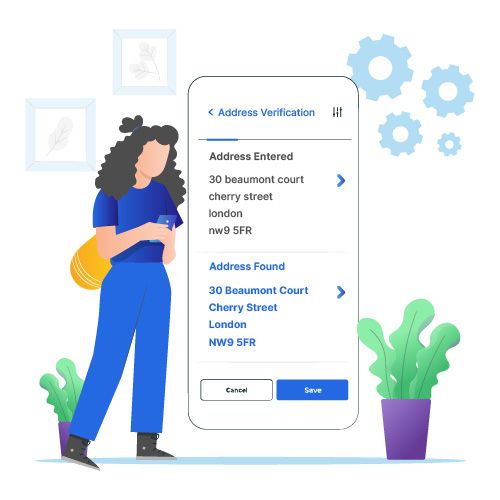What is a Postal Code
What are Postal Codes and How Do They Work?
Businesses of all kinds are familiar with terms like address cleansing and ZIP+4 code. They are aware that you need a complete ZIP+4 code to send and receive packages via USPS without any delays and to ensure the mail’s deliverability. Yet, businesses often remain ignorant of what is what and focus solely on their campaigns/efforts and their reach.

Businesses must realize that they need to have a comprehensive idea of what is what if they are to come up with feasible and innovative solutions. You can’t be inspired to come up with a smart solution or alternative with a limited understanding of what you are dealing with. And as far as a company’s direct mail efforts are concerned, the postal code is the perfect place to start.
You need to understand what is postal code so that you can have a better understanding of how your direct mail efforts work. This article discusses what postal code is, how the ZIP+4 code fits into pictures, and how it is important for your address verification and validation process.
What is Postal Code?
Postal codes are a set of numbers, a very specific set of numbers (although it sometimes includes letters too) that helps postal services determine the destination of a mail. The postal code allows a mail to reach its destination, and full ZIP+4 makes sure that it reaches the destination ASAP. The use of postal code is standard practice across nations all around the world. Even though the details may be different, the basic functioning is similar everywhere.
The postal code system across different countries may vary, and so will their format but their purpose remains the same, and that is to make postal delivery easier. Every stage in postal delivery is optimized by the use of postal codes. This optimization includes the batching of posts sent to a particular state to the stage where the postman makes the delivery. In essence, the postal code dictates the extent of the delivery jurisdictions.
So, every address that falls under the same delivery jurisdiction will have the same postal code assigned to it. However, this broad classification only applies to a part of the code if you are referring to a full 9-digits postal code. It is also worth noting that sometimes the postal codes are based on their geographical areas or even administrative boundaries in some cases. On the flip side, sometimes they are free-floating in nature or integral to a certain organization or a single delivery point.
It may feel that the postal code allocation may very well be random with so many different bases for their allocations, but there exists a common element between all of them. And what is that? Well, the postal codes are closely linked to the delivery route of a postal employee. It makes perfect sense to do it this way because the purpose of the postal codes in effect is to streamline their delivery process, reducing the time required for deliveries through effective planning.
How the Postal Code was Created
The postal codes had a massive impact on all the activities related to postal delivery, and this goes for every country in the world. A system that is simple yet effective enough to manage the postal operations of big countries such as the US. As an address verification company that works closely with postcodes, we can’t help but get a little excited when talking about the origin of postal codes.
So the story begins when the cities in the US started to grow bigger and bigger. As the cities kept on growing, the delivery of postal mails also became more and more challenging. Soon there were not enough postman or post offices to deliver all the letters; keep in mind that this was at a time when letters were the only means of communication for the vast majority of the population.
The most obvious solution at this point was to simply meet the increased demand for postal services was optimize the logistic capability of the postal body. To optimize the logistical capabilities, more post offices were built and more postmen were hired. But the problems were only beginning because the postal delivery was potentially a management nightmare.
Why? Because despite having new post offices and new postmen to deliver the mails, it still did not rectify the problem of how one would find the different addresses. There were a lot of questions that were left unanswered, such as which post office would deliver an address that is exactly halfway between two post offices? An efficient way had to be developed that is productive in a way that none of the resources went to waste.
A similar situation prevailed in different parts of the world during the time. It was in London that they first started using the postal codes in the late 1800s. London was subdivided into ten different districts to meet the postal delivery requirements and is often signified as the first source of postal codes. They called these newly classified districts postal districts or postal zones.
To keep track of them effectively, they were all numbered, and that is how “postal district numbers” or “postal zone numbers” came into being. Although during the first World War, such systems already existed in various European countries, the one from London is often regarded as the origin.
The US began using the postal code system a bit later but not later than the 1920s. Since then, the postal delivery system has gone through numerous changes and optimized for better and faster deliveries. Even with all the progress that we have made since then, the district numbering system is still the foundation on which the modern-day postal codes are built on.
Using Postal Codes Across the Country
The postal code that had its inception in London was merely the tip of the iceberg. The district code created in London was a primitive one because they only ever covered a big city and nothing more. As one would expect from a new system, even though it had some sound logic behind the first postal code was not effectively implemented. The system was perfected over the years and evolved itself to what we now see around the world.
For starters, the first postal code was created only for big cities like London. It was never equipped to cover larger areas like states or the country. They lacked the systematic superiority to implement them on a larger scale. It was the Ukrainian Soviet Socialist Republic that first implemented a country-wide postal code system back in 1932. However, this did not last as they failed to implement it efficiently, and it was finally discontinued in 1939.
If you are looking for a functioning example of a postal system in history, then you will have to go to Germany in 1941. Even though they were dealing with the war at the time, the Germans still managed to keep effective postal communication throughout the country. Later in 1963, the US also joined the club by implementing the ZIP-code system. In the meantime, it took another decade for the UK that actually began the practice of postal code to implement it nationwide.
But we have not once had to look back ever since the introduction of a nationwide postal code system. The beauty of the system and probably the reason that it has not been replaced by an alternative system is its ability to expand. It allows countries to expand and accommodate for new or additional areas simply by adding new digits to the already existing code.
The postal codes are much more than just a means of delivering direct mails today. They help in geocoding, address validation, and more. They can help you with identity verifications and even checking for stolen credit cards. At this point, the postal code is not something you can afford to be ignorant about because it has many real-life uses, and you never know when you might need one in your personal or professional life.
International Mailing Postal Code Names
We have already made it clear that countries around the world use a postal code system. However, it is not necessarily called a postal code everywhere around the globe. It’s similar to how in the US we call an elevator an “elevator,” and in the UK, they call it a “lift,” and we haven’t even considered the non-English speaking countries yet. Every country has a different term, and below we take a look at some of the most popular ones.
In the US, we call the postal service the ZIP code or “Zone Improvement Plan.” The “Postal Code” is a generic term, and it is universally applicable, and it also happens to be the name used by Canada’s postal service. Many English-speaking nations like the Netherlands use the name Postcode which, as you can see, is just a slightly different variant of the “postal code.” In Italy, they call it CAP, which is short for “Codice di Avviamento Postale” which further translates to Postal Expedition Code.
In Ireland, the postal code goes by the name Eircode, which is their latest delivery code system. Brazil calls it “Código de Endereçamento” (CEP), which in English means Postal Addressing Code. In India, the postal codes go by the name “Postal Index Number code” or PIN code/Pincode. The Germans call it “Postleitzahl” or PAZ, which conveniently translates to “postal code.”
Postal Code and Their Different Formats
Although there are certain generalities when it comes to postal code format, they still have many variations, and it is essential to understand these different formats. Beginning with the characters used in the postal codes, you need to keep in mind that the actual composition may vary depending on the country, and hence all the places may not necessarily use all the characters.
You can expect three kinds of symbols in a postal code. The first of these symbols that you will notice are the numbers 0 to 9, or the ten base characters of the Arabic decimal system if you want it in technical terms. As you may have very well guessed, the second of these symbols are the alphabets A to Z or all 26 letters of the basic Latin alphabet. The third and final one of these symbols is the hyphens and spaces.
The majority of the countries use only the numbers in their postal codes. However, it is worth noting that the hyphens and spaces are also used in varying saturation levels. That being said, this is not always the case as some countries out there use a more complex system that throws in alphabets to the mix, making their postal codes alphanumeric. Canada, Venezuela, the United Kingdom, Swaziland, Netherlands, and Ireland are some of the more popular countries that employ an alphanumeric postal code.
The Role of Location in Mailing Postal Codes
Instead of assigning random numbers and letters to addresses around the city (or country, for that matter), the postal codes are attributed based on their location and deliverability. Grouping together the addresses in a systematic manner makes way for easier labeling. Take the ZIP codes in the US. For example, the first digit of the full 9-digits ZIP code indicates the region of the country where the postal mail is destined to go.
Suppose the first digit of the ZIP code is 0, then it is headed for New England, and similarly, each digit specifies a particular region in the country. However, you should remember that this system may change from country to country. As far as the US is concerned, its codes are generally based on the administrative areas. This means that the first number of the ZIP code will give you a fairly accurate idea about the destination country.
That being said, on the practical side of things, ZIP codes often cross county, city, and state boundaries. So what does this mean for the postal code? Well, this means that although it is likely that the ZIP codes are closely linked to the administrative boundaries like city and states, it is by no means compulsory. As we briefly mentioned before, it all comes down to optimizing the delivery process, and hence the most productive way for running the mail is adopted.
Another thing you should be aware of is that sometimes when the codes are not based on a boundary, they are tied to the recipients. For example, PO boxes usually have their own postal code or postal code suffix. It is also normal for large buildings and organizations to have their unique codes because of the large volume of mails they send and receive.
Postal Code Accuracy
The postal code accuracy can also be subject to variation from country to country, meaning some codes can be more accurate, or some may be less accurate. The ZIP code used in the US comes with what is called a “block-level” accuracy. This implies that the mails sharing the same ZIP+4 code will be delivered by the same delivery man or share the same delivery route. This is one of the most accurate postal codes in the world, and the USPS assures delivery as long as you have a validated address.
Conclusion
The Postal Code system is an international system used across countries around the world. Although its name, application, and mode of operation can change from country to country, the basics remain the same. The postal code used in the US is the ZIP code, and it comes with a “block-level” accuracy which is one of the best in the world.
However, the postal code accuracy is not worth much if you do not have a validated set of addresses, and this is especially important for businesses who regularly send out postal mails. You need an advanced address verification tool like PostGrid that can provide you with an accurate ZIP+4 code of the addresses so that you can ensure that your marketing efforts are functioning in their optimal condition.
Ready to Get Started?
Start transforming and automating your offline communications with PostGrid
The post What is a Postal Code appeared first on PostGrid.
Via https://www.postgrid.com/what-is-postal-code/
source https://postgridplatform.weebly.com/blog/what-is-a-postal-code



Comments
Post a Comment